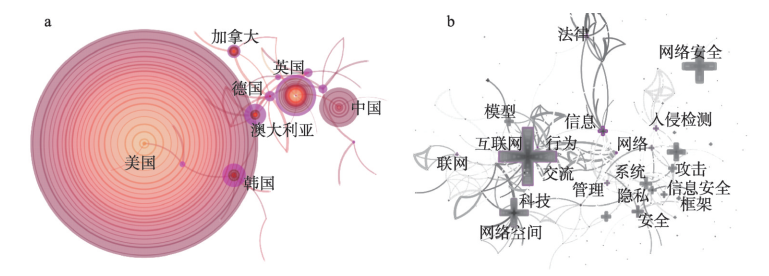

The theoretical basis and technical path of cyberspace geography
Received date: 2019-08-26
Request revised date: 2019-09-16
Online published: 2019-09-25
Copyright
As a new spatial form of human activities, cyberspace is the common carrier of human and information. Cyberspace security is an important foundation of national security. The scientific description of cyberspace is an important cornerstone of cyber event analysis, cyberspace governance and cyber security guarantee, and also a new field of geographic science research in the information age. In the context of rapid development and fierce competition in global cyberspace, it is urgent to strengthen the intergration of geography and cyberspace security, and to carry out theoretical and methodological innovations based on traditional geosciences, and to create cyberspace geography. Cyberspace geography is the extension of geoscience research content from real space to virtual space. Its theoretical basis has evolved from the traditional theory of man-land relationship to the theory of man-land-network relationship; its research contents include constructing the mapping relationship between cyberspace and real space, redefining the basic concepts of distance and region in cyberspace, constructing the language, model and method system of cyberspace visualization, drawing the cyberspace map and exploring the evolution laws of the structure and behavior of cyberspace; its technical path includes the data collection and fusion of cyberspace elements, the visualization of cyberspace and the intelligent cognition of cyberspace situation and behavior. The intelligent cognition covers the assessment of cyberspace situation, transmission and traceability analysis of network hot events, situation simulation and risk prediction of cyber events, etc. The establishment of cyberspace geography will certainly provide a new perspective for the scientific cognition of cyberspace, the discipline construction of geography and cyberspace security science, as well as the prevention and control of national cyber security and the construction of a community of common future in cyberspace.

GAO Chundong , GUO Qiquan , JIANG Dong , WANG Zhenbo , FANG Chuanglin , HAO Mengmeng . The theoretical basis and technical path of cyberspace geography[J]. Acta Geographica Sinica, 2019 , 74(9) : 1709 -1722 . DOI: 10.11821/dlxb201909001
Tab. 1 Contrastive analysis of attributes between geography and cyberspace geography |
| 对象 | 地理空间与地理学 | 网络空间与网络空间地理学 | |
|---|---|---|---|
| 空间表征 | 现实空间 | 虚拟空间 | |
| 研究对象 | 人地关系 | 人地网关系 | |
| 尺度表达 | 多种空间尺度 | 任意空间尺度 | |
| 属性特征 | 基础设施 | 机场、港口、桥梁等基础设施 | 路由器、服务器等网络基础设施 |
| 资源属性 | 实体资源有限的资源量 | 实体资源和虚拟资源无限的资源量 | |
| 行为属性 | 物质流、能量流等实体流行为 | 信息流、网络流等虚拟流行为 | |
| 关系属性 | 相邻、相交、包含等空间关系 | 网络拓扑关系 | |
| 自然属性 | 受自然条件的影响 | 不受自然条件约束 | |
| 社会属性 | 实体社会 | 网络社会 | |
| 经济属性 | 实体经济产业 | 互联网产业等 | |
| 城市属性 | 看得见的城市 | 看不见的城市、共享城市 | |
本文写作过程中召开了四次网络空间地理学研讨交流会,感谢王瑛玮、徐云峰、祝国邦、范春玲、陆磊、胡光俊、孙德刚、吴钰、徐帆江、王志伟、荆涛、程健、何书金、李嘉欣、高卿等提出的宝贵意见和建议。
| [1] |
[ 郭宏生 . 网络空间安全战略. 北京: 航空工业出版社, 2016.]
|
| [2] |
|
| [3] |
[ 皇安伟 . 2018年全球网络空间安全动态发展综述. 网信军民融合, 2019(1):66-70.]
|
| [4] |
|
| [5] |
[ 林伯海, 刘波 . 习近平“网络空间命运共同体”思想及其当代价值. 思想理论教育导刊, 2017(8):35-39.]
|
| [6] |
|
| [7] |
|
| [8] |
[ 钱学森 . 论地理科学. 杭州: 浙江教育出版社, 1994.]
|
| [9] |
[ 张焕国, 覃中平 . 演化密码引论. 武汉: 武汉大学出版社, 2010.]
|
| [10] |
|
| [11] |
|
| [12] |
|
| [13] |
[ 张龙 . 与地理空间紧关联的网络空间地图模型. 信息安全学报, 2018,3(4):63-72.]
|
| [14] |
[ 齐爱民 . 论网络空间的特征及其对法律的影响. 贵州大学学报(社会科学版), 2004(2):16-22.]
|
| [15] |
[ 孙中伟, 路紫, 王杨 . 网络信息空间的地理学研究回顾与展望. 地球科学进展, 2007,22(10):1005-1011.]
|
| [16] |
The White House. National security presidential directive/NSPD54/homeland security presidential directive/HSPD-23[EB/OL]. ( 2008- 01- 08) [2016-09-17]. .
|
| [17] |
Presidency of the Council of Ministers. National strategic framework for cyberspace security [EB/OL]. ( 2013-12-01)
|
| [18] |
Russian Federation Council. Концепция стратегии кибербезопасности российской федерации [EB/OL]. ( 2014- 01- 10) [2016-09-24]. .
|
| [19] |
[ 方滨兴, 邹鹏, 朱诗兵 . 网络空间主权研究. 中国工程科学, 2016,18(6):1-7.]
|
| [20] |
[ 黄少华 . 论网络空间的社会特性. 兰州大学学报, 2003,31(3):62-69.]
|
| [21] |
[ 沈逸 . 全球网络空间治理与金砖国家合作. 国际观察, 2014(4):145-157.]
|
| [22] |
[ 蔡翠红 . 国家—市场—社会互动中网络空间的全球治理. 世界经济与政治, 2013(9): 90-112, 158-159.]
|
| [23] |
[ 侯云灏, 王凤翔 . 网络空间的全球治理及其“中国方案”. 新闻与写作, 2017(1):5-9.]
|
| [24] |
|
| [25] |
[ 宋文龙 . 欧盟网络空间多层治理模式及启示. 学习月刊, 2016(16):17-19.]
|
| [26] |
|
| [27] |
[ 张漪墁, 赵小林 . 网络安全度量与评估的分析与研究. 中国科技论文在线精品论文, 2018,11(4):328-338.]
|
| [28] |
[ 王慧强, 赖积保, 朱亮 , 等. 网络态势感知系统研究综述. 计算机科学, 2006(10):5-10.]
|
| [29] |
[ 黄丽民, 王华 . 网络安全多级模糊综合评价方法. 辽宁工程技术大学学报, 2004,23(4):510-513.]
|
| [30] |
[ 张拥军, 唐俊 . 基于云模型的网络安全态势分析与评估. 计算机工程与科学, 2014,36(1):63-67.]
|
| [31] |
[ 赵泽文 . 广域网网络空间安全防御综述. 科技广场, 2015(3):117-120.]
|
| [32] |
[ 王朱劳 . 入侵检测技术在网络安全中的应用分析. 数字技术与应用, 2019,37(1):209-210.]
|
| [33] |
|
| [34] |
[ 陈至立 . 辞海. 上海: 上海辞书出版社, 2009.]
|
| [35] |
[ 陆大道 . 中国地理学的发展与全球变化研究. 地理学报, 2011,66(2):147-156.]
|
| [36] |
[ 马蔼乃, 邬伦, 陈秀万 , 等. 论地理信息科学的发展. 地理学与国土研究, 2002,18(1):1-5.]
|
| [37] |
[ 周成虎, 鲁学军 . 对地球信息科学的思考. 地理学报, 1998,53(4):372-380.]
|
| [38] |
[ 高俊 . 图到用时方恨少, 重绘河山待后生: 《测绘学报》60年纪念与前瞻. 测绘学报, 2017,46(10):1219-1225.]
|
| [39] |
|
| [40] |
[ 孙中伟, 王杨 . 信息与通信地理学的学科性质、发展历程与研究主题. 地理科学进展, 2013,32(8):1266-1275.]
|
| [41] |
[ 艾廷华 . 适宜空间认知结果表达的地图形式. 遥感学报, 2008,12(2):347-354.]
|
| [42] |
[ 吴传钧 . 人地关系与经济布局. 北京: 学苑出版社, 1998: 28-33.]
|
| [43] |
[ 毛汉英 . 人地系统与区域持续发展研究. 北京: 中国科学技术出版社, 1995: 48-60.]
|
| [44] |
[ 陆大道, 郭来喜 . 地理学的研究核心: 人地关系地域系统—论吴传钧院士的地理学思想与学术贡献. 地理学报, 1998,53(2):97-105.]
|
| [45] |
[ 方创琳 . 中国人地关系研究的新进展与展望. 地理学报, 2004,59(Suppl.1):21-31.]
|
| [46] |
[ 李凤华, 王彦超, 殷丽华 , 等. 面向网络空间的访问控制模型. 通信学报, 2016,37(5):9-20.]
|
| [47] |
|
| [48] |
[ 王纪武, 郑浩宇 . 网络空间概念、属性、作用与城市规划响应. 城市发展研究, 2016,23(9):40-45.]
|
| [49] |
|
| [50] |
|
| [51] |
[ 姜亚丽 . 实体的物理空间与网络空间的信息映射规则与方法的研究[D]. 大连: 大连工业大学, 2012.]
|
| [52] |
[ 李威 . 基于IP地址的网络实体地理位置定位技术研究与实现[D]. 北京: 北京交通大学, 2012.]
|
| [53] |
[ 张果 . 网络空间论[D]. 武汉: 华中科技大学, 2013.]
|
/
| 〈 |
|
〉 |